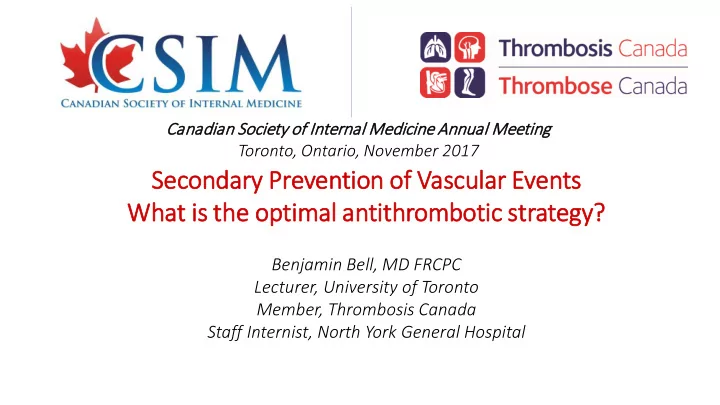

Canadian Society o of I Internal M Medicine A Annual Meeting Toronto, Ontario, November 2017 Seconda dary Prevention o n of V Vascul ular E Eve vents Wha hat i is t the o e opt ptimal antithr hrombo botic strateg egy? Benjamin Bell, MD FRCPC Lecturer, University of Toronto Member, Thrombosis Canada Staff Internist, North York General Hospital
Canadian Society o of I Internal M Medicine A Annual Meeting Toronto, Ontario, November 2017 Conflict D t Disclosures The speaker has received fees/honoraria from the following sources: BMS/Pfizer, Bayer, Boehringer Ingelheim, Servier, Leo Pharma Some of the drugs, devices, or treatment modalities mentioned in this presentation are: ASA, clopidogrel, prasugrel, ticagrelor, rivaroxaban
Objectives • Review risk of secondary vascular events in those with established vascular disease • Discuss recent advances in this area • Compare benefits and harms of long term dual antiplatelet vs aspirin/anticoagulation strategies
Background • Atherosclerotic cardiovascular disease is common • 4% of worldwide population (300 million) • Higher in Western countries • ASA is the standard antithrombotic agent for secondary prevention • but MACE (CV death, myocardial infarction, stroke) occurs at a rate of 5- 10%/year in optimally managed patients • Small studies have demonstrated inconsistent benefit for dual antiplatelet therapy • Warfarin +/- ASA reduces MACE but is associated with excess major bleeding, including ICH
“DAPT Trial” n=9961
DAPT design ASA + P2Y12 n=5020 R PCI * 1 year standard antithrombotic ASA + placebo therapy (ASA + P2Y12) n=4941 Efficacy outomes 18 months -MACE (CV death, MI, stroke) -Stent thrombosis Safety outome -Moderate & severe GUSTO bleeding Most patients on clopidogrel
Mod-severe bleed ARI: 0.9% NNH: 111 Fatal bleeding Same
MACE ARR: 1.6% NNT: 63 ACS ARR: 2% NNT: 50 Death ARI: 0.5% NNH: 200
“PEGASUS Trial” n=21,162
PEGASUS design ASA + ticagrelor 90 mg BID n=7050 ASA + ticagrelor 60 mg BID R ACS n=7045 1-3 years “standard” therapy ASA + placebo (mean 1.7 y) n=7067 33 months Efficacy outome -MACE (CV death, MI, stroke) Safety outome -TIMI major bleeding
PEGASUS efficacy results MACE • MACE reduction driven by all components • Significant reductions in ACS, stroke individual outcomes • No significant difference in rates of death from any cause MACE ACS Stroke ARR 1.23% ARR 0.78% ARR 0.4% NNT 81 NNT 128 NNT 250
TIMI major bleed ARI: 1.24% NNH: 81 Fatal bleeding Same ICH Same
AUGUST 27, 2017 “COMPASS” n=27,395
COMPASS design ASA 100 mg daily n=9126 ASA + BID Any history of CAD or PAD Rivaroxaban 5 mg BID placebo run-in Mean duration 7.1 years R CAD PAD n=9117 Riv 2.5 mg BID + ASA 100 mg daily n=9152 Efficacy outome 23 months -MACE (CV death, MI, stroke) Trial terminated early due to clear superiority of Riv+ASA arm Safety outome -modified ISTH major bleed
Baseline characteristics Rivaroxaban + aspirin Rivaroxaban Aspirin Characteristic N=9,152 N=9,117 N=9,126 Age, yr 68 68 68 Blood pressure, mmHg 136/77 136/78 136/78 Total cholesterol,mmol/L 4.2 4.2 4.2 CAD 91% 90% 90% PAD 27% 27% 27% Diabetes 38% 38% 38% Lipid-lowering 90% 90% 89% ACE-I or ARB 71% 72% 71%
R + A R A Rivaroxaban + aspirin Rivaroxaban N=9,152 N=9,117 N=9,126 vs. aspirin vs. aspirin N N N HR HR Outcome p p (%) (%) (%) (95% CI) (95% CI) CV death, 379 448 496 0.76 0.90 <0.0001 0.12 stroke, MI (4.1%) (4.9%) (5.4%) (0.66-0.86) (0.79-1.03) 160 203 0.78 195 0.96 CV death 0.02 (0.79–1.17) 0.69 (1.7%) (2.2%) (0.64-0.96) (2.1%) 83 117 142 0.58 0.82 Stroke <0.0001 (0.65–1.05) 0.12 (0.9%) (1.3%) (1.6%) (0.44-0.76) 178 182 205 0.86 0.89 MI 0.14 (0.73–1.08) 0.24 (1.9%) (2.0%) (2.2%) (0.70-1.05) Death from 313 366 378 0.82 0.97 0.01 (0.84–1.12) 0.67 any cause (3.4%) (4.0%) (4.1%) (0.71–0.96)
R + A R A Rivaroxaban + aspirin Rivaroxaban N=9,152 N=9,117 N=9,126 vs. aspirin vs. aspirin N N N HR HR Outcome p p (%) (%) (%) (95% CI) (95% CI) CV death, 379 496 0.76 0.90 ARR 1.3% <0.0001 0.12 NNT 77 stroke, MI (4.1%) (5.4%) (0.66-0.86) (0.79-1.03) 160 203 0.78 0.96 ARR 0.5% CV death 0.02 (0.79–1.17) 0.69 (1.7%) (2.2%) (0.64-0.96) NNT 200 83 142 0.58 0.82 ARR 0.7% Stroke <0.0001 (0.65–1.05) 0.12 NNT 143 (0.9%) (1.6%) (0.44-0.76) 178 205 0.86 0.89 MI 0.14 (0.73–1.08) 0.24 (1.9%) (2.2%) (0.70-1.05) Death from 313 378 0.82 0.97 ARR 0.7% 0.01 (0.84–1.12) 0.67 NNT 143 any cause (3.4%) (4.1%) (0.71–0.96)
Primary: CV death, stroke, MI
Major bleeding R + A R A Rivaroxaban + Aspirin Rivaroxaban N=9,152 N=9,117 N=9,126 vs. Aspirin vs. Aspirin Outcome N N N HR P HR P (%) (%) (%) (95%CI) (95%CI) 288 255 170 1.70 1.51 Major bleeding <0.0001 <0.0001 (3.1%) (2.8%) (1.9%) (1.40-2.05) (1.25-1.84) 15 14 10 1.49 1.40 Fatal 0.32 0.41 (0.2%) (0.2%) (0.1%) (0.67-3.33) (0.62-3.15) 28 43 24 ICH 0.60 0.02 1.80 (0.3%) (0.5%) (0.3%) 1.16 (1.09– (0.67–2.00) 2.96) Non-fatalother 42 45 29 1.43 1.57 0.14 0.06 criticalorgan (0.5%) (0.5%) (0.3%) (0.89-2.29) (0.98-2.50) TIMI major bleeding ARI 1.2% 21 NNH 83
Summary • Adding antithrombotic medications to ASA in those with established atherosclerotic vascular disease… • is efficacious in preventing MACE • associated with excess (major) bleeding • has not been associated with mortality benefit • Further study and/or subgroup analyses are needed to… • define subgroups who stand to benefit most • define the optimal strategy (ASA + P2Y12, ASA + OAC, other…) • determine optimal timing of initiation of multimodal antithrombotic meds • We must optimize such patients in other/less toxic ways • lifestyle • targets (glycemic, lipid, BP) • appropriate meds (ACEi/ARB/BB/statin/MRA), where indicated
Recommend
More recommend